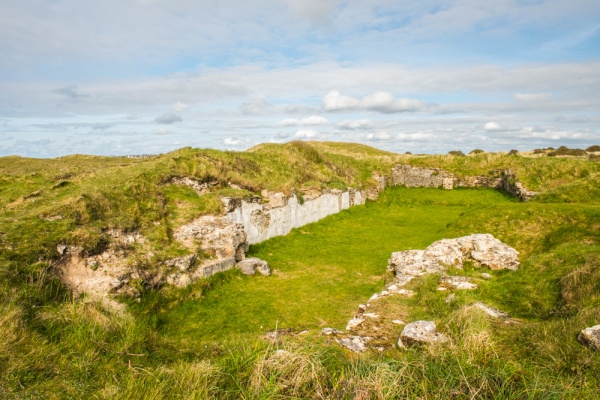
Amid the windblown dunes of Penhale Sands, near Perranporth, lie the remains of St Piran's Oratory, one of the oldest and most important sacred sites in Britain, second only in age to Iona Abbey in Scotland. The Oratory was established by Piran, or Perran, a 6th-century Irish monk. When the Oratory was engulfed by sand in the 10th century a new church was built a hundred yards or so to the north, sheltered from the sand by a small stream. It is possible that the new church and the older Oratory co-existed for a time.
In a curious twist, this new church was in turn overcome by the sand after tin mining caused the stream to dry up. In 1804 it was abandoned too, and a new church built several miles inland. So the 'new' church is now known as St Piran's Old Church to distinguish it from its 19th-century replacement.
But we're getting ahead of ourselves. The Old Church was built as the local parish church, but by the 12th century it had been re-founded on collegiate lines, with a priest and several canons.
An early Victorian writer described the collegiate church thusly:
'The manor or honor of St. Piran, now destroyed by the sands, belonged to a college of canons, by whom it was held free of all taxes ... it is said to have been, at a latter period, the property and seat of the family of St Piran, from whom it passed by successive female-heirs to the Kendalls and Vincents.'
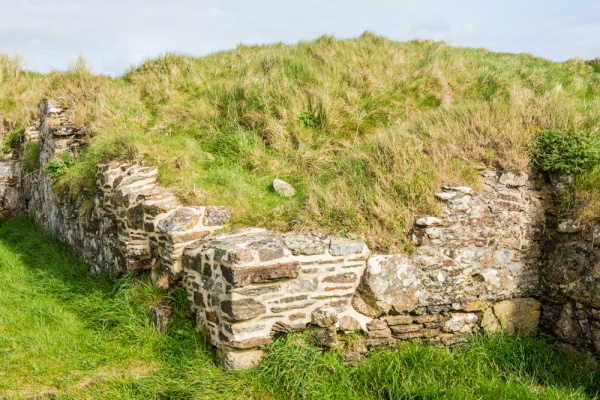
The college of canons looked after a reliquary in the form of a silver casket, which was said to contain the skull of St Piran. Pilgrims made the journey to see the skull and the church became a popular stopping place for those travelling to Compostela in Spain.
St Piran's relics were sometimes carried in a procession around Cornwall. In addition to the silver casket, the procession included a bejewelled pastoral staff covered with silver and gold, a copper bell, a silver cross, and a cross made of bone.
The saint's relics were lost at the Reformation, and the church drifted into obscurity. Perhaps drifted is the right word, for drifting sand eventually became such a problem that in the 17th century the local people petitioned the canons of Exeter Cathedral to move the church to a safer site. The move was not agreed for a century, and the last marriage ceremony was held here in 1795, though burials continued until 1835.
The Old Church was dismantled stone by stone and carried the two miles to the new church site at Perranzabuloe. The Old Church site was then left to be buried beneath the sand.
A report in 1820 paints a vivid picture of St Piran's Old Church, describing it as 'ruinous, being divested of its roof, pillars, window frames and tower. Broken walls, staring windows and shattered tomb-stones are here seen in melancholy confusion, while the interior of the ruin is filled with sea sand'.
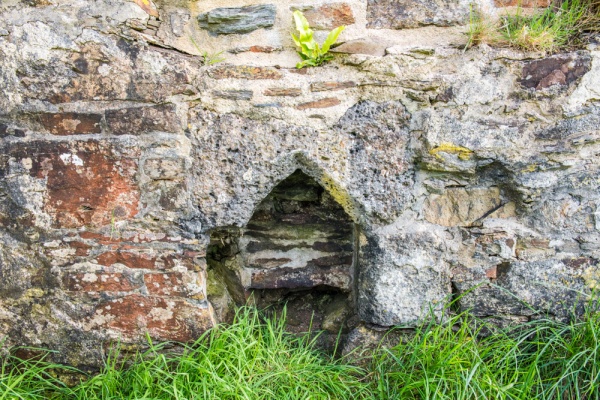
The site was excavated by archaeologists in 1917. Dr TFG Dexter found that the original 10th-century walls still stood up to 1.5m high in places. He also found the site of the old burial ground, marked by an earth bank.
In 2005 the St Piran Trust excavated the Old Church, an extraordinary process that involved digging up 250 tonnes of sand from the church interior. The excavation revealed an old gravestone lying in pieces within the church. It appeared to have been thrown down during the 1804 move to the new church. It commemorates John Resugga and his wife, with a date of 1628.
The oldest part of the church is the chancel; a small rectangular enclosure measuring 6m x 9m. This small structure was enlarged over the early medieval period to create the present building layout, with a nave, south aisle, south transept, tower, and (possibly) a north transept.
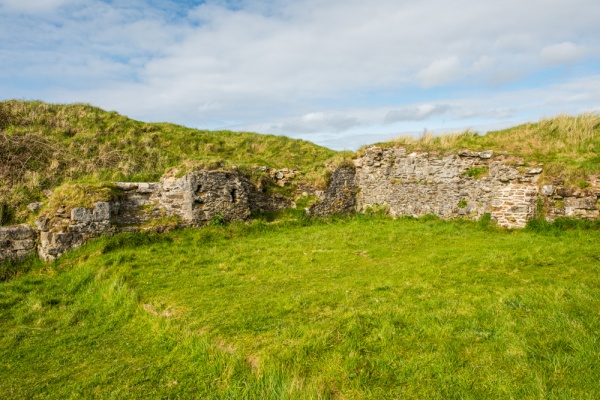
Just a few steps from the church stands St Piran's Cross, a wayside cross dating to at least the 11th century and possibly earlier. It is thought to be the oldest such cross in Cornwall. Both the cross and the church lie within the large oval burial ground, which may have been formed from a much earlier prehistoric burial enclosure.
There may have been a small settlement around the church, as a geophysical survey of the area revealed remains of structures nearby as well as the remains of numerous small fields. These are all now lost beneath the sand.
A short walk to the north brings you to St Piran's Oratory, which has now been excavated.
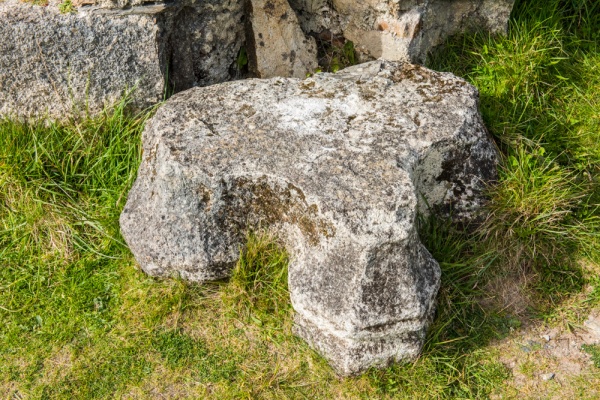
Getting There
It isn't particularly easy to find St Piran's Old Church or the earlier Oratory. The easiest way to get here is probably to take the B3285 heading north from Perranporth and turn left onto the minor road to Cubert, heading towards the hamlet of Mount. After a few hundred yards you come to a layby opposite the lane to Rose and Rosehill.
From the layby, just south of Gear Farm, paths meander onto Penhale Sands. An Ordnance Survey map will help enormously, but even with a map, it can be confusing. The OS maps show a footpath leading almost directly to the Old Church, but the reality is that numerous paths dissect the Sands at all angles, and it isn't clear which path you need.
Keep heading roughly north-west towards the sea and you will eventually find the cross and church to your right, with a path leading left towards the Oratory. There are no obvious signposts anywhere, so it pays to be patient. There is, however, an information panel outside the church, explaining the history of the site.
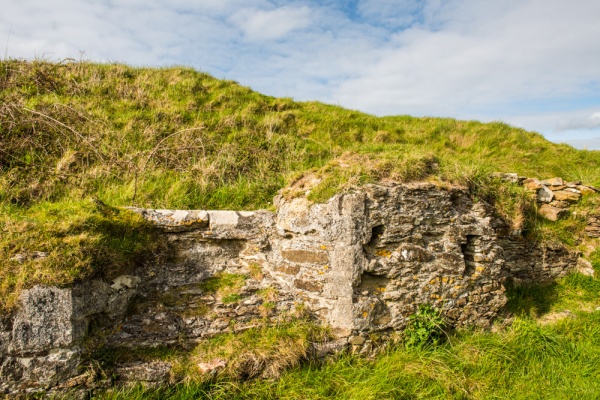
About St Piran's Old Church
Address: Penhale Sands,
Perranporth,
Cornwall,
England
Attraction Type: Historic Church
Location: Access by footpath across Penhale Sands, off the minor road between Perranporth and the hamlet of Mount. The nearest post code is TR4 9PN.
Website: St Piran's Old Church
Location map
OS: SW771564
Photo Credit: David Ross and Britain Express
HERITAGE
 We've 'tagged' this attraction information to help you find related historic attractions and learn more about major time periods mentioned.
We've 'tagged' this attraction information to help you find related historic attractions and learn more about major time periods mentioned.
Find other attractions tagged with:
NEARBY HISTORIC ATTRACTIONS
Heritage Rated from 1- 5 (low to exceptional) on historic interest
St Piran's Cross - 0 miles (Prehistoric Site) ![]()
St Piran's Oratory - 0.2 miles (Historic Church) ![]()
Cubert, St Cubert's Church - 1.2 miles (Historic Church) ![]()
Perran Round - 1.3 miles (Prehistoric Site) ![]()
Perranzabuloe, St Piran's Church - 2.8 miles (Historic Church) ![]()
Trenance Gardens - 4.3 miles (Garden) ![]()
Trerice - 4.5 miles (Historic House) ![]()
Wheal Coates Tin Mine - 6 miles (Historic Building) ![]()



